#Whitbread 1989
Explore tagged Tumblr posts
Text
Interview with Dawn Riley, 1 April 2024
KaiYves (KY): Hey, everyone, my name is KaiYves from A Solitary Sea Rover, and I’m here with Dawn Riley at Oakcliff Sailing Center, an incredibly famous veteran of offshore sailing. You were in the Whitbread twice, I think?
Dawn Riley (DR): Uh-huh.
KY: Which is now The Ocean Race, in 1989 and then 1993, and then the America’s Cup in 1992, 1995, 2000, 2003, 2007…
DR: 2003, I did the easy part, I was media. (laughs)
KY: And you were in management for–
DR: For 2007, yup.
KY: And today you’re the head of Oakcliff Sailing Center, since 2010, I think?
DR: Yup, absolutely.
KY: And you’re also, as of last year, in the America’s Cup Hall of Fame.
DR: Yes, I’m a triple-famer. America’s Cup Hall of Fame, National Sailing Hall of Fame, and then the Michigan Sports Hall of Fame. So three different organizations, all honoring sailing.
KY: And it only took 30 years.
DR: (laughs) Yeah.
KY: And now there’s four women in the America’s Cup Hall of Fame!
DR: Yup.
KY: …and forty men, right? (laughs)
DR: I have not done the math, but yeah, there’s more men than women across the board. [It's actually more like 100 men and 4 women.]
KY: It’s reflective of the event. So we met at the 12-Metre World Championships last summer in August, that was an incredible weekend, you know, just the level of access there was, being able to walk in and see everyone, being able to see the boats, and photograph them. I was able to help out a little bit.
DR: Yup.
KY: Because you guys needed a phone charger. You let me come on the chase boat, that was incredible, I got to see [the racing] up close… I got kind of seasick, but I still had a wonderful time.
DR: (laughs) Good to know.
KY: And then I helped hose down a little bit afterwards. So I was joking with my friends that I can tell everyone that I was a 12-Metre crewmember for five minutes.
DR: There you go. (laughs) And Courageous is a pretty special yacht.
KY: I said to my friend, “You know, this summer I was a crew member on Ted Turner’s yacht. There’s a lot of clarifiers to that, but…”
DR: (laughs)
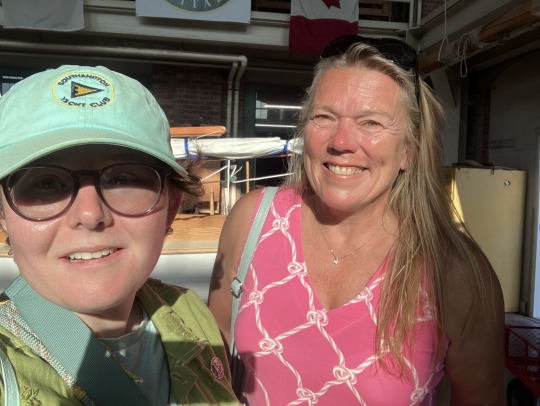
At the 12-Metre Worlds.
KY: In a very loose sense I was, yes. You agreed to do this interview with me and let me come visit and I’m super excited for that. I got my Master’s at NYU and a few weeks ago, I was in Greenwich Village. So I went into the Strand Bookstore, the famous bookstore there, for old time’s sake. I was looking around, I was in the basement stacks, looking at the travel, exploration, transportation sections, and while I was there, this is what I found– (pulls out a book wrapped in cloth from her backpack and unwraps it to show it’s Riley’s book Taking the Helm)
DR: Ah. Taking the Helm. (takes book to examine it) Is this one signed?
KY: Oh, yeah, it is.
DR: I think I signed almost all of them.
KY: So I don’t have to bother you for that.
DR: There you go. (laughs)
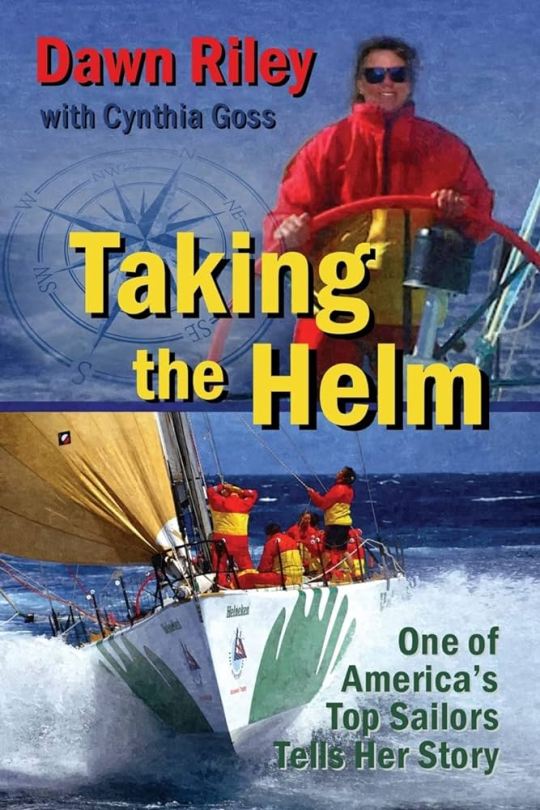
This is the softcover cover, mine looked slightly different.
KY: I thought, “This is great”, because I’d already made the arrangement to talk to you, “This is a good omen, I think”. It also has this flier from back in the day. (unfolds a paper flier tucked into the dust jacket and hands it to Riley)
DR: Oh my goodness, this is funny. Yup, this was the promo that I sent out. I put together this flier myself and it was to try and do speaking. That’s crazy, I haven’t seen that in for-ever.
KY: Do you want to keep it?
DR: Um, sure. I don’t think 1-800-511-DAWN works anymore, but I’ll check.
KY: You find some really great things at Strand, you know. I found, um, Bertrand Piccard, who went around the world in the balloon, I actually found a signed copy of his book about that at Strand.
DR: Mmm-hmm, OK.
KY: I found a book about the ‘77 America’s Cup that had a newsletter from the ‘83 one inside of it and I said, you know, “I think the flier might be worth more than the book, but…”
DR: (laughs)
KY: So used bookstores are amazing.
DR: Hmm-hmm.
KY: But I was really excited [to read your book] because it was actually the third book I had read about that era of the Round-The-World Race in the past year. I’m working on a fictional story that’s about a fictional team in the 80s in the Whitbread, so I’d read a few different books. I’d read Peter Blake’s book about Ceramco in 1981, I’d read Skip Novak’s about Drum in ‘85– I think you have most of those out there [on the bookshelf in the main room]. And so, I wanted to see and contrast the different people’s voices and so forth. I know I contrasted those [two] as I was reading. I thought, you know, Blake had this very fun, optimistic sort of voice where it’s all this very jolly adventure.
DR: Peter Blake was a good friend of mine. He was an amazing seaman. He and his wife were adventurers. And unfortunately, tragically, he was killed on an adventure in the Amazon. But he was probably one of the most solid and most revered New Zealanders out there.
KY: It was a great book, you know, just this good humor throughout. Whereas Skip Novak’s, it’s a lot more gritty and cynical. He’s talking about people fighting each other, talking about people doing unsanitary things and stuff like that. And I actually thought, just, the way the book opens, where they come into Cape Town really early in the morning and nobody’s there to greet them because they’re sixth, it’s just the officials. And they spray them with champagne and he’s like, you know that’s always the cheap champagne and it makes you sticky and it’s nasty. And he’s like, and now we’re in Cape Town, it’s 1985, and there’s all of these signs that say, ‘No Black People [Allowed] Here’. And so, he’s just very much showing the grittier side of his experience.
DR: Or, more, just the pessimistic side. Knowing Skip, that’s his personality.
KY: Yes.
DR: So both of those people’s personalities come through.
KY: But he also in the end enjoyed this adventure and he still thought it was worth it. So I liked having those two different perspectives. And so I was curious to see, when I read your book, how your perspective compared. And I think you have more of an optimistic voice.
DR: I am eternally optimistic. If I wasn’t, I would not have made anything of my life, because everyone told me I couldn’t. I said, “Oh yeah? Screw you, watch me.” So I’ve been forced to be, but luckily eternally optimistic. Which doesn’t mean I am a Pollyanna. So I’m realistic and prepared as well.
KY: I mean there were some, you know, gritty details, but I thought that it was, overall, more of a “Blake” sort of voice. But what I thought that was in your book that was not really in the other ones was a lot more about emotions and familial connections. And just talking about the people back home and everything. Which is something that made it kind of different. And some really beautiful language.
DR: So I have to have joint credit for that with Cyndy. I kept a running [log], I wrote it during the race and then she cleaned it up. And went back and forth and back and forth on the editing. So it was absolutely a joint editing process. And sometimes my language was way too flowery and she’d bring it back down, and sometimes hers was a little too professional and I’d be like, “That doesn’t sound like me!”, so I’d bring it back.
KY: I love when you’re talking about how you left South America and you were under a sky full of diamonds, going out into a sky full of diamonds.
DR: Yeah, there’s… It was just a couple of years ago, now, so it’s 2024… before COVID, so say 2018, I was down in Florida on a beach… (a phone in the office rings and Riley stops to press a button to silence it) I walked down to the beach at a party and there was nobody else around. I looked up at the sky, I was like, “This is what I miss. I miss being out there.”
KY: I mean, it must be, it’s some of the darkest skies on Earth when you’re in the middle of the ocean.
DR: Yes, of course, you’re out– there’s some points, and I think this was described in the book, some points where you can’t really tell where the sky ends and the water starts. ‘Cause it’s just a circle.
KY: And I loved that. Because I feel like a lot of the time, when you read books from people who did something really interesting, their skills are not in writing so they describe it very simply.
DR: Uh-huh.
KY: And I’m like, okay, so you flew around the world or you climbed Mount Everest, but I don’t really get a sense of what it was like for you. But with you, I did.
DR: Okay, good.
KY: And what I also liked about that book was that I was able to see connections because I’ve read a lot of other books from the same time period. Because I go to used bookstores and people give away their books about twenty-five years afterwards. So, I was like “Oh!” At the same time [you were racing the Whitbread], there was the ENZA trimaran going for the Jules Verne Trophy, which I had read— actually, just the year before— read Cam Lewis’s book about Commodore Explorer.
DR: Uh-huh.
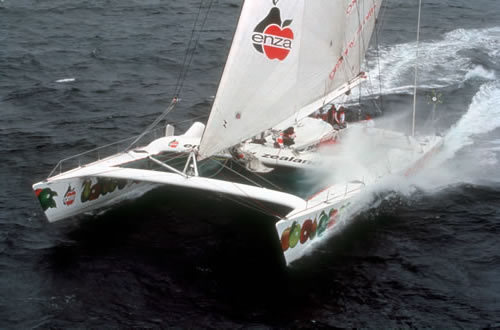
The Jules Verne Trophy, not quite like the book. [x]
KY: And then, at the same time you were planning for the America’s Cup 1995. And during lockdown, I actually read Anna Huntington’s book Making Waves.
DR: Yup.
KY: That’s always, to me, a very particular experience reading that book, because I got it from Breakwater Yacht Club, I borrowed it just before lockdown and then I had it. There was nothing else to do so I just was biking around in the spring. And I went to this little beach in North Sea and I just sat down on the beach and I was just reading this book and trying to think about something– just something else because it seemed like the world was going crazy. And there was an osprey family up in a nest. And it was just me, and the osprey, and this book about the America’s Cup.
DR: Uh-huh.
KY: So you’ve made a home here [on Long Island] in our area, but you’re from Detroit, originally.
DR: Yup.
KY: And you learned to sail there?
DR: I learned to sail with my family. No formal training, no junior sailing type of training, but my dad was a sailor and a racer and he would basically, I think… My mom would say, “Take one of the kids, get out of the house!” So I got to go, because I was the oldest, which was pretty cool. So I think the first sailboat race that I did, for sure, the first one that I can remember, I was about four years old. And they did a crash gybe, and I got rope burn under my arm, and I thought it was amazing. My mom wasn’t so happy. But they also did not put limits on it. So I started racing on bigger boats in the– in the 70s, Jesus.
KY: So did you have, at that point, heroes as a kid that you looked up to in the world of sailing?
DR: When you’re that young, the only peers you have, the only people you know about, are your family. When we came back from sailing for a year, on the year’s cruise, I obviously had my eyes opened by seeing all the different places and all the different jobs in the industry. From, you know, powerboat captains to workers, to engine repair, to riggers in the Caribbean. You know, all of that just exposure, Antigua Race Week… hippie yacht captains, Jimmy Buffett, Ted Turner, who we met on the dock, a sailboat racer with TV cameras following him… so that was a whole exposure. And then when I got back, and started racing, the people in the industry, the professionals in the industry, were my role models. Sailmakers and boat workers, boat captains.
KY: And this was the year that your family went to the Caribbean, you said?
DR: Yup, we did that when I was 13, so I started working and being paid to work on boats when I was 15, and put myself through college doing that.
KY: That must have been incredible, just being with your family in the Caribbean like that and going from place to place.
DR: Uh-huh. Yup, it was very organized and scheduled. Lots of sailing events. We went as far as you could, I think as far as you possibly could on a 56-foot wooden boat in one year and seven days. Because we had an extra week. My dad had two leaves of absence, but he worked for a week in Puerto Rico to make it up. So one year and seven days from the time we departed to the time we got back. We were on a schedule, we rarely stayed in the same place more than one night at a time. So it was pretty cool.
KY: When you were growing up, as a teenager and so forth, what was your awareness of the America’s Cup and then the offshore sailing?
DR: My awareness of the America’s Cup was discovered during that year’s cruise. When we were in Newport, in ‘77, the trials were going on. And then, I didn’t really know about the Round-The-World-Race because there had been no stopover in America until the race we did. But when I came back, at North Star Sailing Club, on Lake St. Claire, there was a film on the Whitbread, and I’m like, “Oh! I want to do that!”
KY: You were a teenager when you decided you were going to do that.
DR: 15, yeah. Maybe 16. Probably in winter. 15 or 16, it doesn’t matter.
KY: But that was your moment. And you followed on that course to become a professional from that point on?
DR: Well, professional back then wasn’t really a word. You were a boat captain. The professional/amateur only came into it in the 2000s when there was a marketing push from the Farr office that was building boats and started saying, you’re professional, you’re amateur. And I kind of got a little bit screwed over in that. Thank God I had enough time before people discriminated against professionals. Because we were poor and we needed to work to be able to sail. And I was able to get my skillset up. But basically, as I wanted to go sailing, I needed to eat and I needed to pay for college. So I had a job working on boats and sail lofts and cleaning boat bottoms and making sandwiches and anything I could do to keep those two things. I wanted to sail, I needed to eat, oh yeah, and I needed to pay for college.
KY: And you had the aspiration to go as far as you could?
DR: No, I wanted to do the America’s Cup and I wanted to do the Round-The-World, but I also thought maybe I wanted to go to the Olympics. And I also thought I wanted to be an advertising executive on Madison Avenue. So I kept a lot of different goals and I didn’t really know that it was a possibility to continue in the sailing until I didn’t get a job in advertising. And then I was ready. So what I tell people here at Oakcliff is that you absolutely have to have a plan. And whether it’s going to be school, family, real job, business, boatbuilder starting a business– but you always have to have your seabag packed and ready to go when an opportunity presents itself. And that’s kind of what I did.
KY: I’ve actually (laughs) I’ve actually had the worst luck trying to watch the Maiden documentary. There’s been places that I’ve been where it was showing and I kept missing it. And I got the DVD now and I was trying to watch it last night and my computer is new and I hadn’t set up the DVD program, and so I only got to watch, like, the first half-hour.
DR: Oh, bummer.
KY: So I’m sorry I can’t ask you too many questions based on that.
DR: It’s okay. I will tell you that the movie is quite realistic. And they were talking about trying to make a Hollywood remake of it, and I don’t know how that would be possible. Because the footage was so good, the story was so well-done, and the only thing you could add to make it more Hollywood, honestly, would be romance. (laughs)
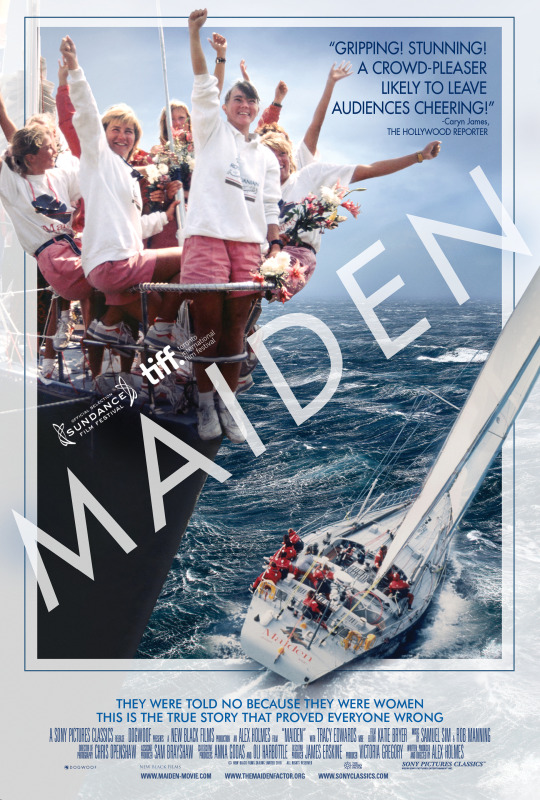
[x]
KY: That was the ‘89 race, and y’know, it really was just, I feel like there has to be some kind of movie about the ‘89 race, not necessarily about Maiden in particular. But just because there were so many different events going on, it almost doesn’t seem real that it was at this point in the world– that the Berlin Wall came down and…
DR: We weren’t even aware that that was happening because we were out at sea. There was satellite navigation really around the middle of the Earth, around Antarctica you were still using celestial. The electronic communications for weather– we would get a weather fax that was on that fax paper, where you get it too hot or wet and you can’t read it. There was a positioning once a day, but our only communication was SSB ham radio, single-sideband. So we weren’t picking up on the news.
KY: I have the “Maxi” book that I saw on the shelf, I got that one at Strand also, and I was looking through that and looking at the computer technology that they had onboard as research for my story. But just this… you came back to port and you would get all of this news that the world was changing so rapidly in this period. Did you have a sense that, y’know, something’s in the atmosphere?
DR: No, no, no, no. We were just isolated. I was literally talking about this last night with a friend’s nephew who just came back from Germany. He hasn’t been in America for three years. And I said, at least you have the Internet, because when I used to come back to do an event or a speech or something, I would at the airport, get People Magazine. Because there was no social media, there was no TV that we were watching. And I came back and there was a social event and people were talking about “Britney”. And I’m like “Who the heck is Britney and what’s her last name?”
KY: Britney Spears.
DR: Because if you’re gone and you’re not hearing it, you have no idea and the whole social world has passed you by. So you have to do some homework to catch up.
KY: In some of the books, they say, you know, the world could end and we wouldn’t know until we got to port.
DR: Uh-huh.
KY: I think in Skip Novak’s book, he said that they were at sea when the Chernobyl accident happened and they had heard that on the radio, and they were like, “What if we come back to the northern hemisphere and everyone’s dead of radiation poisoning?”
DR: Right, right. You are isolated, out there. Or you were isolated out there. Nowadays it’s much different. Nowadays, I think it’s lost a lot of the romance. There’s more people following– you see Cole Brauer and half a million people following, but is that entertainment or adventure? I’m not sure which.
KY: That was the first time you had been to the Southern Ocean, right?
DR: Yes.
KY: What was that experience like, being there for the first time?
DR: (deep exhale) Everybody says they want to be helicoptered in just for a day, which would be a disaster. Because the way that you acclimate to the Southern Ocean is that it’s a little windier, it’s a little windier, it’s a little windier, and each step up, you’re like “Oh my god! Oh, oh, oh!” And then on the way back down, as you’re coming out, you’re walking around in 50 knots of wind with a cup of coffee and you’re not spilling it. So it’s an acclimation, it’s not like you’re helicoptered in, “This is the Southern Ocean!” It’s a gradual in and a gradual out. There are moments you absolutely remember, just the amount of energy and extremeness and the adrenaline of sailing is pretty cool.
KY: From what they say, it sounds like it’s almost a world apart. Otherworldly.
DR: It is, I mean, everybody talks now about Point Nemo, we didn’t even really talk about that then, which is when you’re closer to the space shuttle than you are to land.
KY: Francis Chichester, he said, “I felt like I was planetary distances away from the rest of mankind.”
DR: OK, I wasn’t that eloquent.
KY: But was it like you were on another planet?
DR: We were racing as fast as we could to get to the next piece of land. And that is the thing people always ask, “Are you bored?” No. Because you’re in a competition, it might be a very long competition, but you’re in a competition. And yes there’s some fun times and there’s some relaxing, there’s laughs. But you’re focused. When you’re steering the boat, you’re trying to steer the boat as best as absolutely possible. When you’re trimming, you’re trying to do it as best as absolutely possible. You’re just doing it for a really long time.
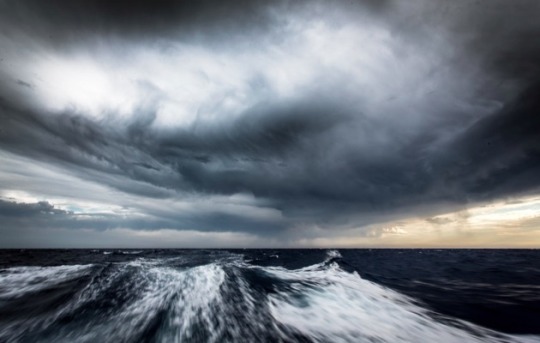
It sounds pretty intense. [x]
KY: And there were several different nationalities onboard Maiden. It was organized in England and it was majority Brits, so how did you feel as an American being among Brits?
DR: Well, it wasn’t majority British, if you count Welsh, and Irish and Scottish, which they absolutely would. There were three proper English onboard. And then, it was weird being the only American only in that it was the first time I had ever been in an experience where I was the only American. I wasn’t even aware of a lot of the stereotypes until they started teasing me about it. “Seppo? What’s Seppo?” It’s like, septic tank. (laughs) But I didn’t know.
KY: It’s the Australian word for Americans, yeah. You know, when I’ve been doing the research for my writing, I type in “Whitbread Race” [in a search engine] and one of the suggestions is “Did Maiden win the Whitbread Race?” Because it’s become so famous now because of the documentary. So how do you feel knowing that you guys are now the most famous team that was there in 1989?
DR: Well, that’s fine. There was also the photo of my cleavage that was the most published photo of all of 1989. Or actually, 1990, because of the finish in Fort Lauderdale. In 1990, the absolutely top-published photo in sports was of my cleavage.
KY: …I’m sorry.
DR: (laughs) Back then, I wasn’t embarrassed, I didn’t even really care about it or know about it, but I was not a fan of coming into Fort Lauderdale as sailboat racers, in our bathing suits, because I thought it cheapened what we were doing. And I was quite against it. Ironically, then that photo came out and now I look at the photos and I’m like “Oh, if only I looked like that now!” (laughs)
KY: Did you have that, you know, almost stereotypical expression after you came back, thinking “I won’t do that again!” or did you immediately say, “I want to do that again next time.”
DR: Neither. I figured, I’ve checked the box, now what am I going to do? I was literally trying to decide between the Olympics and the America’s Cup when we finished. I did not intend to do the next race, I only did it because there had been a mutiny and I had to save the reputation of ‘89-90, because if the women had failed, then it would have been a step backwards further than before Maiden. Because Maiden was about “Can they do it?” “Yes, they can? Oh, that was a one-off.” That would have been the story.
KY: So you did the America’s Cup in 1992, and you were the first woman in a physically-active role [on an America's Cup crew in 140 years].
DR: Mmm-hmm.
KY: How did you end up joining that team?
DR: Open try-outs. There was a handful of women that tried out. I was just the only one that made the team.
KY: This is also, significantly, this is also the year in which there is the movie made about the America’s Cup, Wind, that’s the fictionalization of the events of 1983.
DR: That’s right, that’s right.
KY: And that’s kind of an alternate universe sort of story, but it struck me that this film that was set ten years before did have female crew, something that only became a reality that same year.
DR: I didn’t even think about that. I was so busy just training to go racing.
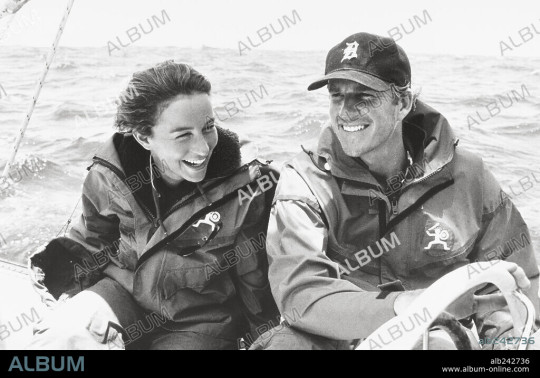
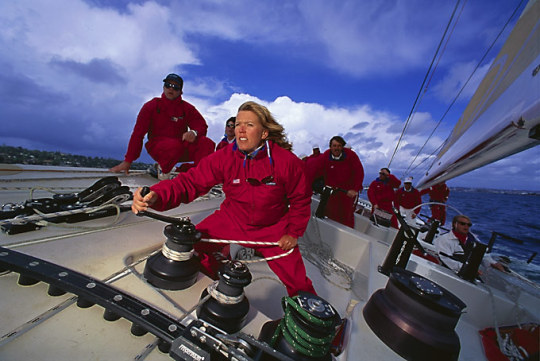
Left: Fiction, Right: Reality
KY: Were you aware of the movie when it came out?
DR: Oh, of course. We were aware of the movie. And I think I remember thinking it was okay. Everybody teased, everybody was joking about it. But I think it was pretty successful, pretty well-done. I had actually been asked to be in the film as a stunt-double at one point, and I thought they were joking. It turns out that they were, but it doesn’t matter– I was busy.
KY: Yeah, it’s one of those love-it-or-hate-it movies, y’know? I love it, I know people who hate it, but I love it.
DR: I don’t hate it at all. I’ve watched it a few times. There was a movie called Masquerade that I liked better, and it didn’t get nearly as much press.
KY: I like to joke with my friends that I’m one of the 600 people on Earth who have actually seen Wind.
DR: Oh no, I think there’s a lot of people that have seen Wind. Every junior sailing kid who has been at a program when there’s no wind out, gets to see Wind.
KY: You were part of America^3–
DR: America Cubed.
KY: Yes, America Cubed. Did you have the sense that you were the first?
DR: Oh yes. They maximized it in terms of publicity. We had three of us, there were two black guys on the team. So Art, myself, and Billy Ruh would go. It was the girl, the cute white guy, and the star black guy, we’d call ourselves the Mod Squad.
KY: Oh, like the show, yes.
DR: Which was a TV show from the 60s.
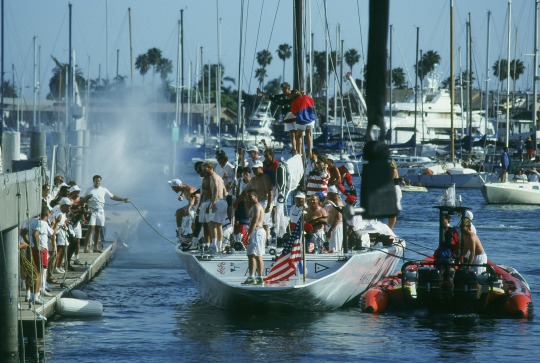
The America^3 crew were nicknamed "The Cubens" (pronounced like "Cubans") [x]
KY: So then you were in the Whitbread in 1993 again, like in the book. You joined the team after Leg 1 because there had been the mutiny and so forth… I almost don’t even want to ask anything because you said it all so well in the book!
DR: (laughs) So then just tell everyone to read the book. You can buy it now [online], it’s in paperback because we sold the 50,000 copies in hardback.
KY: In the book, there’s the contrast between the management side of the team and so forth and dealing with the lawsuits and the money troubles, whereas you said when you’re out at sea, you’re focused on very specific tasks. So did you actually prefer the simplicity of focusing on what was going on aboard ship.
DR: It’s ironic. Because when you’re out there, all you really… it’s actually pure. It’s wonderful. It’s amazing, because you’re just focus, focus, focus. And you’re just trying quickly to get to shore. And with the second attempted mutiny on the boat while we were racing kind of took that purity away, so it wasn’t as good as with Maiden. The second time around the world or the second time you’re in the America’s Cup is never as pure and fun with that sense of discovery as the first time. The ironic part is that you’re racing and all you want to do is get to shore and see people and have a glass of wine and have actual vegetables that aren’t freeze-dried. And then you get there and somebody hands you a beer and then you forget about all of that. The first couple of days onshore are really annoying because there’s so much distraction and then you get into a routine and then before you go back, you are like “Ohhhhhh, I don’t want to go to sea, I want to stay in bed.”
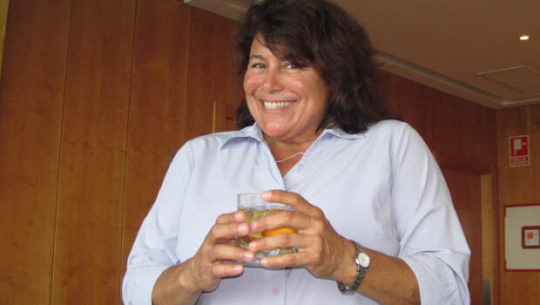
[x]
KY: You captured that so well, talking about being in South America and hearing the winds keeping you up at night. And in the book you wrote a lot about Gloria Borrego, who recently passed.
DR: (quietly) I know.
KY: She sounded incredible. Could you talk about her?
DR: She was incredible. She worked in the pits in NASCAR, she was a brilliant engineer, a problem-solver, always laughing. Amazing. Diana Klybert wrote her obituary, which summed up more than any of us knew in terms of one aspect of her, and it was tragic that she got cancer and died within two weeks. One of my other friends, mutual friends, was upset and said that she had so much left to do. But I pointed out, she had done so much.
KY: Just the good humor that came through in the book, where you were joking among yourselves, she was talking about her dreams, and she talked about how she dreamed she was a superhero. That was incredible, just so fun to read.
DR: Yup.
KY: And you also talked about how you were getting letters from students and that you were impressed that people were following you.
DR: Yes, because you wouldn’t remember, you weren’t alive. [Actually, I was seven months old when the 1993 Whitbread started, but close enough.] But the Internet was just starting to happen and CompuServe was the e-mail. So we would sent a fax to a supporter in… Annapolis, I think? And then he would e-mail it out, because you couldn’t take a picture then, you couldn’t send attachments, he would re-type it into an e-mail and send it out to people via fax or e-mail. It was basically an early version of a listserv.
KY: Yeah. I think that really the Whitbread and the America’s Cup were kind of pioneers in using the Internet for education [and outreach] and that way of letting people follow. The Whitbread website from 1997 had almost all of the modern features and everything! I know that in the 1995 America’s Cup, there was the PACT organization that was doing newspaper things for students every week. Really impressive stuff.
DR: Sailors are early adopters. Because we are so remote.
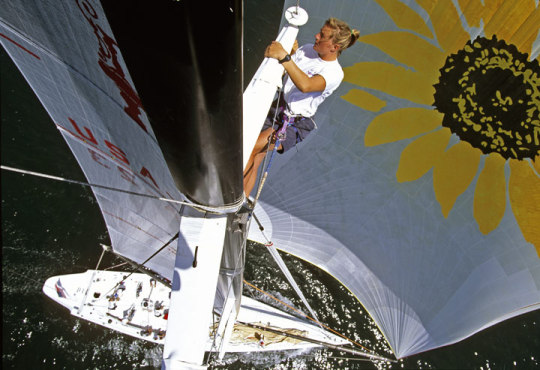
America^3 in 1995. [x]
KY: 1995, you were with the other America^3. Where it was specifically a women’s team. So that was, I suppose, the next step, now that there had been female crew, that there had been–
DR: 1995, yeah. It was basically because Bill Koch and his financial advisors didn’t want him to spend all of this time and money and effort to do it again and underwrite it.
KY: He had to do something different.
DR: And so they came up with the idea of, should we do an all-women’s team. They asked me, and I said, “Noooo, let’s just sail mixed, it’s more fun.” And then I sat down and helped write the business plan for that, we called it the Manifesto, but it was a business plan.
KY: I just thought when I read Huntington’s book and it was talking about the team dynamics and so forth and who’s in charge and interesting like that, talking with the trainers and so on. And here’s now we do certain things. I thought it was very funny, the story about forcing one of the chase boat guys to listen to you [all] talking about menstrual problems because he had been annoying or something.
DR: I don’t remember, there was a lot of funny stuff like that. Now, Anna was a rower, she came in kind of late on the team, but her background was journalism, so she wrote a journalistic story, which I fully support. It was slightly sensationalized to be able to sell books, a lot of the other women were very upset because it told too much. My belief is, whatever you do, you should be proud of it. So if everybody knows, it’s on the front page of The New York Times, then tough. You did it, you said it, it’s there, it’s true, share it.
KY: I thought especially talking about the resistance that she faced, I was very impressed by that, it was very scathing in certain places. Talking about specifically the things that people said when they doubted you. I was joking with my friend, I said “She called this book Making Waves because the publisher probably said ‘You can’t call it Screw You, Dennis Conner!’” (laughs)
DR: Okay, yeah. We don’t like Dennis, but he’s now old, he’s older. He’s, yeah…
KY: He disappeared.
DR: Yeah.
KY: And obviously that’s another incredible year in the history, with so many things going on, you literally saw a boat sink in the racing–
DR: Yeah.
KY: –and the different nationalities involved, of course it’s the year that Team New Zealand are just sweeping through. So, again, did you have this sense of being impressed that so many crazy things are going on and you’re in the midst of it?
DR: You’re in the midst of it and you’re trying to just get stuff done. It was a different campaign. It was extremely unfortunate that we had no women in the leadership onshore, obviously we were on the boat, but you need to have that crossover and it was just math, to a point. Because if there had been more women that had had experience in the past, then we would have had more women on the coaching staff, more women on the design team, more women in the marketing team. So you would have had more of a cohesive team, as opposed to the guys do this half, all the business, and the women just hurry up and go sailing. Which hurt us a little bit in some of the decision making.
KY: Yes, I got that sense from the book. And then you did have a mixed team in 2000, with America True.
DR: And we hired the designer of the boat that sank. (laughs) Because he was definitely not going to build a boat that was going to sink.
KY: (laughs) I’ve actually read the official program for that edition, I got it online, and I have a question I’ve gotta ask…
DR: Hopefully I know the answer.
KY: Why was Godzilla on America True’s hull?!?
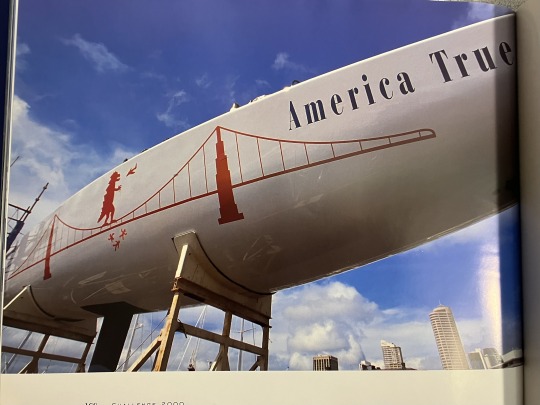
Reproduced from Challenge 2000: The Race to Win the America's Cup, by Russell Coutts and Paul Larsen.
DR: That’s because… it’s hilarious. So, in the America’s Cup, there’s extreme security, you’re not allowed to go into another team’s base, you’re not allowed to take photos because of certain parameters and all sorts of stuff. And we did have some espionage, but that was, I’m pretty sure I know who– I’m pretty sure it was a Kiwi– and when we came in in the morning, it was so hilarious. So they’d snuck in and they’d put Godzilla on the Golden Gate Bridge that was on the side of the hull. So it was just a prank. We could have protested them and had “damages” because they were in the base.
KY: They touched the hull.
DR: Some of the people were upset about that, and myself and Chris Coffin just thought it was so f—-ing funny. We were like, “Leave it!” So we left it on forever.
KY: In the photos in the program, it’s there and I thought that you guys did that.
DR: Nope.
KY: But I thought, I’ve gotta ask why. In this case, you were in Auckland and y’know, this is not necessarily the period where it became– because it already was– that it was so integrated into the culture there. Did you have a sense of that, that this is a place where so much of the country is watching this?
DR: Oh yeah. Because I’d lived in New Zealand off and on since 1992. It was my home. I was actually in London a week ago and staying with Jenni and Spike– Jenni was on both Maiden and Heineken and Spike was on New Zealand Challenge– and I said, I think there’s more friends per square mile of mine in New Zealand than anywhere else in the world. Just because I know so many of them and they’re good friends. And I was lucky to be sailing internationally when it was the decades of the Kiwis, and they’ve all gone home to roost.
KY: And you said in Taking the Helm, when you guys got into Fort Lauderdale, you told the people who were not Americans, you said, this is the United States, there’s not going to be as many people as there were in New Zealand because we don’t turn out as much, so…
DR: Well, no, it’s because they didn’t know that the race was happening as much.
KY: Did you have a sense that this was so much a part of the culture, that people are going to recognize you on the street?
DR: They do. They still do.
KY: It’s a very different sort of experience, the way it’s integrated into their culture?
DR: Yeah.
KY: Like you said, Peter Blake was a national hero.
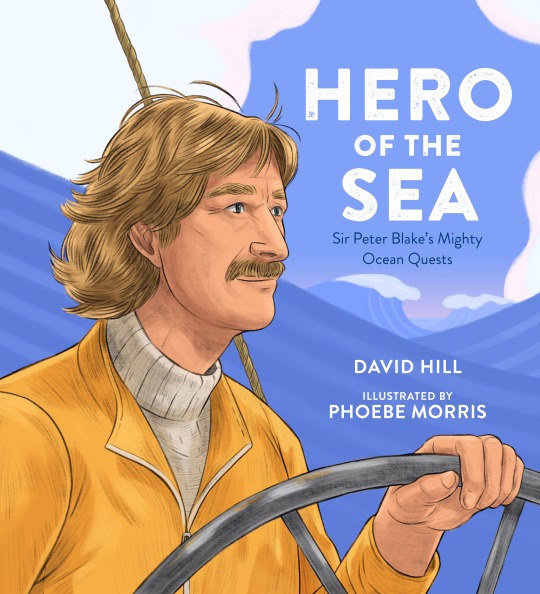
There are even children's books about him! [x]
DR: Well, there’s a big difference. New Zealand has a huge coastline, somewhere around 90% of people go boating regularly, it’s something insane like 86% own a boat, whether it’s a rowboat, or a launch, which is their word for a powerboat, or a yacht, which is their word for a sailboat. So of course you’re going to have more following. As opposed to, how many people in Kansas, Oklahoma, Idaho, North Dakota, South Dakota, y’know, Texas… there’s coastlines somewhere in there, but there’s so much vast, non-coastline.
KY: So would you say that our cultural disadvantage is our geography, in that way?
DR: It’s just different. Just different, yeah.
KY: So then, you were in management and media in the next two editions. Flip those around, media and then management…
DR: I was doing media coverage in 2003 and then I did sail on the boat up until the last 8 months, and I was general manager of the French team for 2007 where we raced in Valencia.
KY: That was K-Challenge. And this is, talking about, three different countries within a decade, that the America’s Cup was in. And with the people who are part of that, involved with that, they talk about their kids going to school in different countries and so forth. So what’s it like, just that nomadic life? Where you know that now we’re here, but we don’t know where we’re going to be in five years because we don’t know who’s going to win? And just going somewhere else, do I have to learn a language, learn basic phrases and so forth?
DR: Well, I mean, that’s a privilege, to be able to go and live in all different countries. Until Oakcliff, I had not lived in any place more than three years after I was 11.
KY: That’s amazing.
DR: It’s cool. And you keep light, you don’t collect a lot of c-—, and you don’t need a lot of stuff. You collect experiences and friends, as opposed to material things.
KY: And I know that in your book and also in Making Waves, you talked about, or people talked about you, reading home and garden magazines because it was something that was different from your own life.
DR: Well, yeah, also if you’re moving to a new place you want to– nowadays we call it nesting– but you want to take the time and that’s you’re creative outlet, to make things pretty. To do gardens. I think somewhere it’s probably written that if I garden, I want something out of it. So I specifically garden with vegetables and some fruits. Flowers are there… marigolds to keep the pests away, but it’s not to make it pretty. It’s to make it productive.
KY: Practical gardening.
DR: Yup.
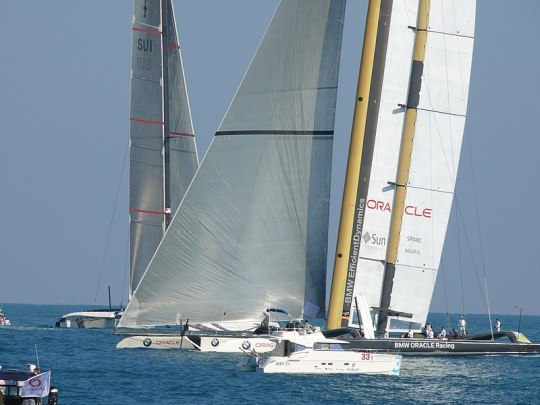
14 years ago, the beginning of the AC multihull era. [x]
KY: Since that point, y’know, we’ve seen the America’s Cup change so much with technology and so forth. And that was sort of the point you moved out of that, you were working at Oakcliff, but how has it been watching all of these changes in the past fifteen years?
DR: (clicks tongue) Yeah, it has been fifteen years. I’m obviously out of the inside scoop on technology, I think the challenge is that there has been a concerted effort to make it marketable to the masses. And when I did the television in 2003, I learned, believed, and reinforced my belief that the way to make it entertaining and relevant to the masses is to educate the masses. Because sports fans, even if they don’t do the sport, want to be seen as the experts, so they can talk about it at the pub with their friends and have an opinion. You need to give them the information so that they can form an opinion in the end. That may or may not be right, because it’s all judgemental, but at least they have the tools. Just making something go fast and not educating people is not the answer. So the catamarans and the foiling gecko boats right now are a challenge on top of the fact that you don’t see the humans. People associate with humans. So I think there’s a lot of people that are in agreement with that, the question is, whoever wins, will they have the cojones to make that correct change.
KY: I’ve seen discussions of this, how much jargon do you use and for what audiences?
DR: Jargon is not a big deal. You say port, left side of the boat, starboard right side of the boat. It’s super frickin’ simple and it doesn’t have to be… it’s not the language that’s the problem. It’s the strategy, the tactics, the humans, why are they doing that? Oh, the wife just had a baby or that person’s mother just ended up visiting in town, the paint is a new coating that they think is faster, is it going to be faster or is more of a psychological advantage? Those kinds of conversations pull people in. And in all of that, I didn’t use a single sailing term.
KY: Right. The thing I was thinking, when I was reading the book on the beach, and it was 2020, I was in lockdown, and I was waiting for the next edition coming up in 2021. And it was at that point that DutchSail had pulled out. And I was thinking, you know, this is 25 years ago, and there was this cohort of women who were crewing, and now they’re not. I felt that this is the light that failed. How did you feel that there has been a technological revolution in the America’s Cup but not necessarily a social one?
DR: Well, there has been. Not in the America’s Cup, but SailGP, the Round-The-World, they’ve gone back and forth between incentives and requirements, and it’s making a difference. The America’s Cup is not going to put those rules in because almost all the rules are some sort of mutual consent, so you have to have at least two parties that are wanting to win to the death. So the only way that you’re going to be able to have women in the America’s Cup, I predict, by regulatory, by rules, is by having a sponsor who says we will give you corporate dollars as long as you have x number of women on the boat. Or you have the challenger and the defender who both believe it’s a competitive advantage for them to have their female on the boat. And then if they both believe that, then you’ll end up with women on the boat. But it’s really hard.
KY: Do you think that if you had been in the match in ‘95, that it would have been different?
DR: No.
KY: That people would have said, see, clearly women can be at least in the match, so…
DR: No. I don’t think anyone makes that distinction. That has nothing to do with it. And also, frankly, the Kiwis were so much faster, that we would have been seen as the women that lost the America’s Cup. So, no.
KY: And then with the set-up they have now, where they made a separate event.
DR: That’s… silly.
KY: Yes! That’s what I was saying, that I feel like previously it was by rule, open, but de facto all-male, now it seems like it’s de jure all-male, because you’re separating.
DR: Where it does help, and where it may help the overall event in the future, is because they’re focusing on women and youth, countries like Holland, Australia, I don’t know the other…
KY: Canada?
DR: Canada, those countries have an entree for young people with a longer runway, launchpad, to get into whatever the next America’s Cup is. So from a marketing perspective, it’s extremely good. Do I wish that we just had women on the real boats? Absolutely. And in particular, in the US, there’s at least two women that are relegated to the women’s team that absolutely should be on the real team.
KY: I feel like when you say “The Women’s America’s Cup”, that’s different from saying “Women IN the America’s Cup”.
DR: Correct.
KY: And with what you were saying, having a women’s team vs a mixed team. That when it’s a women’s team, there’s focus on that, whereas if it’s a co-ed team then it’s just people.
DR: Just people, exactly. We need to sail with people.
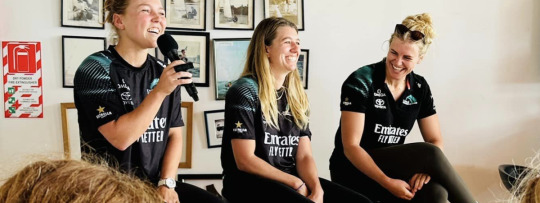
Liv Mackay, Gemma Jones, and Veerle ten Have of the New Zealand Women's America's Cup Team. [x]
KY: Now you work at Oakcliff and you have for 15 years now…
DR: 14.
KY: 14.
DR: It’s only 14. (laughs)
KY: What are some of your duties and responsibilities here?
DR: I’m the executive director and that means doing everything that needs to get done, from making sure that Matt’s buying the right washing machine ‘cause the kids don’t all take c--– out of their pockets and it ends up in the pumps and breaks them– that’s an eight-hundred-dollar mistake– to getting the art show set up, to the fundraising, to coaching the development person about marketing, to cleaning out the shop, to supervising the composites– although Luke’s doing an amazing job there– to sailing, to coaching.
KY: What is this art exhibit?
DR: It’s a fundraiser. So, we have an art show April 6th. We have one every spring. Hunt Lawrence is our main benefactor, and his wife is an artist and she has an art school in New York– New York School of the Arts– so we do a joint fundraiser every spring. And then she does a fundraiser in the fall with art shows. So it’s an art exhibit, there’s a champagne brunch, and all the art’s for sale and a portion, minimum 20% up to 100%, goes to Oakcliff. Hunt doesn’t care as much about all of that, he just thinks it’s really cool that we have a deadline to clean up the place from the winter mess to the summer.
KY: (laughs) Oh my god.
DR: (laughs)
KY: So what is life like for the students here?
DR: You can and should ask them. It depends on the season and the day. I’ve seen more people come through here, we’re at nearly 600 graduates, or over 600 graduates. And some years, it’s kind of the wild west in the beginning, where they’re living offsite and nobody under 18 was allowed. Sometimes we have super-young groups, just because we’re 15 and above. We had one camp where it was 8 boys and girls between 15 and 17, and then 3 women that were in their 60s. And it all worked, but it was awkward in the beginning and it became a great team-building event. At the very end of that particular camp, we had a competition where they divided up into teams and they would do a cooking competition where they could only use stuff that was upstairs, kind of like on Top Chef. They all brought it to my house for lunch and we awarded, I think it was a watermelon soup with a basil-olive oil puree drizzle and a sprinkle of feta that won.
KY: That sounds great.
DR: It was great. It was a 15-year-old boy that made that.
KY: Are you satisfied with what you’ve achieved at Oakcliff?
DR: We’ve achieved amazing things. Our goal right now is to make it sustainable without me onsite and without our main benefactor. So that’s our next frontier. At the same time, we’re under pressure to expand into Florida and to California, which is totally doable but I need to clone myself a couple times.
KY: Now that you’ve had so many people come through, what are some of the things you’ve seen your students achieve?
DR: I go back to Seth Cooley, is one of the top engineers at Future Fibers. Ervin Grove was running the North Sails loft in Charleston. Madeline Baldridge now is married to a coach who was here– and he is a son of our navigator from ‘92, so it’s a small world– she is one of the designers for North Sails. Chris Kennedy works for Melges and he and his wife have a flower farm in Wisconsin. Mark [Towill] and Charlie [Enright] obviously won The Ocean Race. Five of our graduates are working with American Magic. Robyn Lush is working with them a little bit, she’s also become an ultra-marathoner. Koko [Komar] is working in commercial real estate. Mike Nicoletti has a hedge fund. And that’s just off the top of my head.
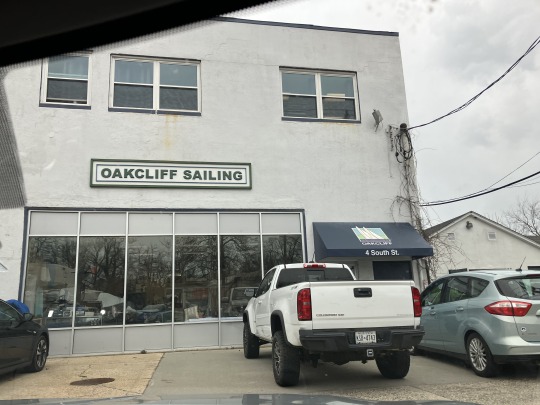
X-Men comics and Percy Jackson novels taught me that all good specialized schools for young people with extraordinary talents must be tucked away in small towns just a train ride away from New York City…
KY: Do you feel like you’re almost, I guess, Professor X, finding the young talent and helping them…
DR: Of course. Of course. We’re giving them the opportunity to come in and try things out. It’s not always an easy thing. And it’s a little bit like I suspect parenthood would be. You’re just like, this kid is driving me frickin’ crazy and they hate me right now, and then 5 years later I’ll get an e-mail from them saying, “I was a jerk, and you were mean to me, but I needed it, thank you.” I just wish I didn’t have to do that over and over and over again. But we try to just keep it at a professional level, acknowledge that we’re asking for ultimate effort, and that not everybody’s going to succeed, but you know where the bar is.
KY: You talked about having the other locations. What are some other things you’re hoping for, for the future of Oakcliff?
DR: Again, the sustainability so that I don’t have to be here. Because it is a model where we have tuition for the Saplings, we have sponsorships, we have art shows. We have income lines, retail, and yet we need to fund-raise for the overhead, essentially. So about 50% of the budget comes from charitable donations. One thing that would make it more sustainable is to be able to get the landlords to agree to sell us the property, because then we would end up net positive on the bottom line. We do a capital campaign so we don’t have to pay rent. We’ve worked on getting the insurance down. So there’s a lot on the business side of it. It’s really boring to people, but we use our dollars. Around 90, I think the lowest we’ve been is 87% of every dollar goes to programming, and we’ve been as high as 96%. So we’re the golden children of utilizing every dollar for programming.
KY: Would you say that your reputation and star power are important to–
DR: My reputation, I’m not going to say star power, but my reputation and credibility is what built Oakcliff. The good news is that 5 years ago, 8 years ago, everything that happened at Oakcliff would reflect on me. Now Oakcliff’s grown to the point that if I just slowly took a backseat, it’s its own entity, which is a sign of success. Because it can’t be attached. If I get run over by a bus, 8 years ago, everybody would say, well, Oakcliff’s done. Same thing with our main benefactor. Now we’re trying to get it to the point that it’s not surrounding just one person. It’s more of the reputation of quality and a community.
KY: And I think we can see that it has to be larger than just the person.
DR: Absolutely.
KY: That the leader is not the whole organization, and if the organization is seen as too closely tied to the leader, then anything the leader does reflects on the organization and that can be a weakness.
DR: Exactly.
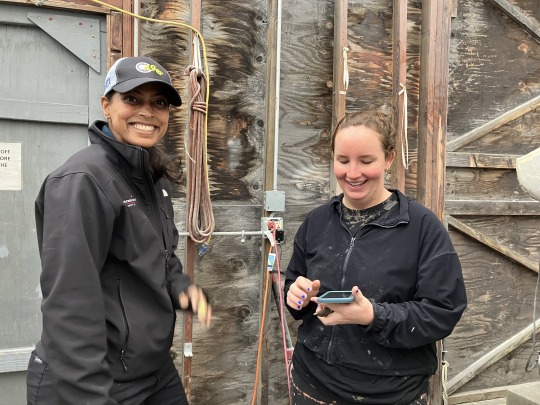
Oakcliff trainees Sweta Shervegar and Noelle Scheer in the boatyard.
KY: We spoke about the role of the sport of sailing in American culture. There has been, I would say, especially with offshore, sort of a decline in visibility in the past 25 years and so forth. And everyone’s got their own reason for that, y’know–
DR: Well, part of it is that it’s become more accessible. Before, there used to be one race, and only a handful of crazy people dared to do it. Now it’s become safer, more communication, more safety equipment, more rescue opportunities, more people. Again, Cole Brauer, in Class 40, livestreaming dinner parties… I mean, I didn’t take a shower for 5 weeks, and I barely had time to write in my diary and drink Ovaltine. Y’know, so, it’s a different… it’s more accessible, so it seems to be easy, but it’s also become more fractured.
KY: There’s many different races attracting attention, but also attention in general is more split because of the Internet and more TV channels. But it seems like, also, I feel like now “sports” means “ball sports” more than it used to.
DR: Say that again?
KY: I feel like now, when I look at ESPN and so forth, “sports” is ball sports more than it necessarily was when you guys were getting your specials on ESPN and so on.
DR: No. When we were back in the day, to have anything on other than football, basketball and baseball in America… even hockey struggled. It’s changed. There’s so much more inventory again, technology allows you to produce high quality broadcast-ready programming, so women’s sports has benefited hugely from that.
KY: Yes.
DR: Sailing is on TV more than you would think, but there’s also more clutter.
KY: I remember when the documentary came out, people said, if Mike Plant had lived, then we would have had an American visibly in the Vendée [Globe] and that would have brought more visibility for offshore [racing] in the United States. And now we do have some American offshore figures with 11th Hour Racing and now with Cole Brauer who are getting all of this attention. Do you think that’s a positive development that we have these people who are…
DR: Yeah. Of course it’s positive. The thing is, how do you channel it for a purpose and what is that purpose? Is it more eyeballs for your sponsors? That’s one thing. Is it more people in sailing? That’s a different thing. Is it a more robust industry? That’s another thing. Is it more environmental and ecology awareness? That’s another thing. Just taking this power, which seems to be scattershot, and putting it into a clear mission and achieving that mission. And all missions are achievable, you just have to know what it is that you’re trying to do. I think Cole is a perfect example. She didn’t expect it. So now it’s going to be really interesting, I think she might be going over to MerConcept. She has power right now, I know she has advisors, and her advisors and she have to make a decision. She could do like Ellen MacArthur. Ellen doesn’t sail at all, but she has her Ellen MacArthur Trust and she uses that to do specific charitable work. I think Cole’s probably too energetic, dynamic to stop there. But what does she want to do?
KY: What do you think that she did well, particularly with the presentation?
DR: The amount of followers she has is crazy. And she has brought in a huge non-sailing audience. And there is a legitimate discussion, like I talked about way back, amongst technical sailors, about the merits and how this happened. And again, she needs to decide what her purpose is and how she’s going to capitalize on something that she’s built that’s amazing.
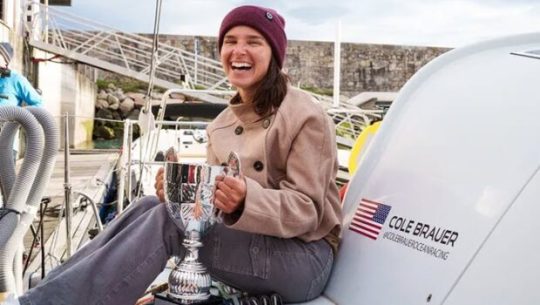
[x]
KY: You were talking about also, the 11th Hour people who came through here. What would you say that they have perhaps done well in presentation?
DR: 11th Hour changed the conversation around the environment hugely and now they’re moving on to women with the MerConcept, which is François Gabart. And that’s Wendy Schmidt, that’s from the top, that’s a female decision-maker and leader.
KY: I wanted to say this before, but talking about the management side as well, you said that there has been a social revolution in the past few decades. I actually saw the interview for the 25th anniversary of America^3, where they had Melanie Roberts who’s the race coordinator for America’s Cup and for SailGP. And that she had been, I think, ten years old watching you guys? [Roberts was actually 9 at the time of the 1995 Cup.]
DR: Oh yes. Yes.
KY: The people on the boats get the most attention, but there are people at all levels who are sort of this generation that has been inspired by the people before them.
DR: Uh-huh. This sport is… it’s complicated. It’s an industry, and a sport, and a lifestyle, and a pastime. It’s all in one. We’re not going to talk about, we don’t need to talk about the Olympics, but that’s part of the national governing body of US Sailing, they also need to figure out what they can do and once they figure that out, they need to do it well. And they’re doing none of it well at this point. Because it’s so complicated. Unlike skiing, perfect example, there’s the Olympic ski team and then there’s the recreational part of it, so all the ski hills have a business association that then spins off some funding for the Olympic team.
KY: Are there any other people you think who are impressive competing nowadays, who came through Oakcliff or otherwise, who you think I should be following?
DR: I started going through names there, Lena Kurbiel is rowing with Liz Wardley [across the Pacific], so there’s one. Sydney Monahan has finished school, she’s going to do a Women’s Match Racing campaign. Sweta, our high-performance coach, is going to go over to MerConcept, Michaela [Robinson] is going to be over there trying out. If I started looking down the 600 people, I would have 600 names for you to follow.
#dawn riley#oakcliff sailing center#interview#female sailors#Whitbread Round the World Race#Whitbread 1989#Whitbread 1993#America’s Cup#AC 28#AC 29#AC 30
10 notes
·
View notes
Text
Tracy Edwards
youtube
Tracy Edwards was born in 1962. Edwards was the skipper of the first all-female crew at the 1989 Whitbread Round the World Yacht Race. Sailing on the Maiden, Edwards and her crew won two out of the six legs of the race and came in second in class overall. In 1990, she was named Yachtsman of the Year. Edwards is the founder of The Maiden Factor Foundation, an organization that raises money to help girls receive a complete education.
4 notes
·
View notes
Text
I was tagged by @samatedeansbroccoli!
Last Song: “Rubberband Man” by The Spinners
Currently Watching: Nothing, last night I watched the remastered 1989-90 Whitbread Race film.
Currently Reading: Nonstop: Driven by the Sea, by Boris Herrmann (well, I’m reading the pages that are in English because I only took one semester of German.)
Current Obsession: Writing, cycling, researching the history of the Ocean Race, appreciating fall.
Tagging: Anyone who wants to play!
2 notes
·
View notes
Text

noticeably in Poland and Lithuania, predominantly Roman Catholic countries. [5][6]
The Satanic Verses is the fourth novel of British-Indian writer Salman Rushdie. First published in September 1988, the book was inspired by the life of the Islamic prophet Muhammad. As with his previous books,
Rushdie used magical realism and relied on contemporary events and people to create his characters. The title refers to the Satanic Verses, a group of Quranic verses about three pagan Meccan goddesses: Allat, Al-Uzza, and Manat. [1] The part of the story that deals with the "satanic verses" was based on accounts from the historians al-Wagidi and al-Tabari. [1] The book received wide critical acclaim, was a
1988 Booker Prize finalist (losing to Peter Carey's Oscar and Lucinda), and won the 1988 Whitbread Award for novel of the year. [2]
Timothy Brennan called the work "the most ambitious novel vet published to deal with the immigrant experience in Britain".
The book and its perceived blasphemy motivated Islamic extremist bombings, killings, and riots and sparked a debate about censorship and religiously motivated violence.
Fearing unrest, the Rajiv Gandhi government banned the importation of the book into India.
[3](4] In 1989, Supreme Leader of Iran Ruhollah Khomeini declared a fatwa against Rushdie, resulting in several failed assassination CLONES
3 notes
·
View notes
Text
Colin/Alina would probably be the biggest non-canon pairing, but not really “crack” because they are friends in canon and depending on how I write the actual 1989 Whitbread when we get there, it’s possible the comics writers were teasing it as a possibility. (And people being attracted to the symbolism of shipping a Soviet woman with someone from the West in the period the Cold War was ending.)
I don’t think there would be a lot of shipping-with-other-GG-members going on, as the only one really of comparable age is Alex Hughes and everyone knows the dominant crack ship there would be Alex/AEGIA.
In the meta-setting, people might crossover-ship Colin and Ororo Munroe as the two most famous weather-controlling heroes in comics.
If your OC’s had a fandom, what would be the most popular crackship pairing?
234 notes
·
View notes
Text
Beer Events 7.6
Events
Emperor Charles V of Spain signed a decree allowing Don Alonso de Herrera to build a brewery, the first in the Americas (1542)
Samuel Whitbread II died (1815)
Henry Johnson patented an Apparatus for Cooling Beer (1886)
Malted Milk 1st for sale (1886)
Lucky Lager bottles 1st for sale (1934)
Richard Cornelius patented a Beer Dispensing Device (1937)
Edward Trump patented a Bottle Capping Machine (1937)
John Lennon & Paul McCartney 1st met (1957)
Phillips Petroleum patented the Concentration of Beer by Crystallization (1965)
Mack Johnston patented a Tapping Device for Beer Kegs (1971)
Trollers Pub, Canada’s 1st craft beer brewery served their first pint (1982)
Michael Jackson Foundation for Brewing and Distilling founded (2020)
Brewery Openings
Yoerg Brewery (Minnesota; 1849)
Trollers Pub (Canada; 1982)
Woinemer Hausbrauerei (Germany; 1987)
Greenshields Brewery (North Carolina; 1989)
0 notes
Text
"A New Wave of Adventure: Women Taking to the Seas in Style!"
Are you looking for a thrilling and adventurous way to explore the world? An exciting new trend is growing in popularity: women taking to the seas in style! With a sail club membership in San Diego, you can join a community of other female sailors and learn the ropes of sailing in no time.
The sailing scene is becoming increasingly popular with women, who are taking advantage of the opportunity to explore and experience the great outdoors in a unique and exciting way. Women are taking the reins when it comes to sailing, proving that anyone can take to the seas in style and with confidence.

One such sailor is Liz Clark, who has been sailing solo for over a decade. Clark is an inspiration to many women who aspire to take to the seas. Her adventures have taken her all over the world, from French Polynesia to the Galapagos Islands, and she has documented her experiences in her book, "Swell: A Sailing Surfer's Voyage of Awakening." But Clark is not the only woman making waves in the sailing world. There are countless other women who are pushing the boundaries of what is possible. Take, for example, the all-female crew of "Maiden," who made history in 1989 by becoming the first all-female crew to compete in the Whitbread Round the World Race.
Sailing is an incredible experience and provides women with a sense of freedom and independence. For some, it also provides a much-needed break from the hustle and bustle of everyday life. Not only that, but it’s also a great way to get out and meet new people and make connections.
With a sail club membership in San Diego, you can join a supportive and encouraging community and learn the basics of sailing. From understanding the basics of navigation and sailing to learning how to rig and maintain a boat, you’ll gain the skills you need to become a confident and competent sailor.
When you’re ready, you can join one of the many local sailing trips where you’ll be able to explore the ocean and its many wonders. From exploring the coastline to sailing the open waters, you’ll be able to experience the beauty of the ocean in ways you never imagined.
If you’re interested in learning more about this exciting new trend, consider getting a sail club membership in San Diego. You’ll be joining a supportive and encouraging community of women sailors, learning the ropes of sailing, and taking part in new and exciting adventures on the high seas. So, what are you waiting for? Get out there and take the plunge!
1 note
·
View note
Photo



Maiden (2018)
Director: Alex Holmes
Stars: Frank Bough, John Chittenden, Bruno Du Bois
The crew (not all for the whole race) were Tracy Edwards (skipper), Mandi Swan (Amanda Swan Neal), Mikaela Von Koskull, Claire Warren, Michele Paret, Tanja Visser, Sally Creaser, Dawn Riley, Nancy Hill, Jeni Mundy, Jo Gooding (from Leg 2), Sarah Davies (reserve), Kristin Harris (Leg 1) and Angela Farrell.
12 notes
·
View notes
Photo
I could absolutely see this as the format for a Marengo-Kazama SPA ad featuring Colin Rodgers’ 1989 Whitbread campaign. (Or for NZ Spirit in the 90s I guess but that would have different aesthetics.)

When ads were cool
571 notes
·
View notes
Photo


Start and finish of the 89-90 whitbread round the world race. Maiden bringing us home after claiming two leg victories in class! First all female crew!
2 notes
·
View notes
Photo
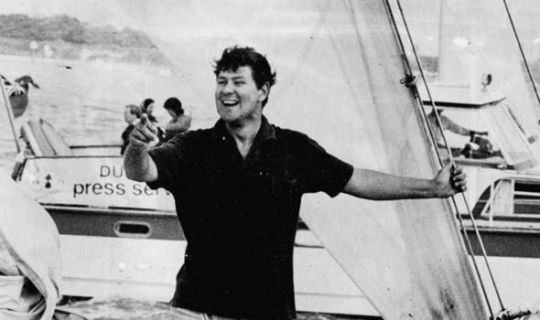
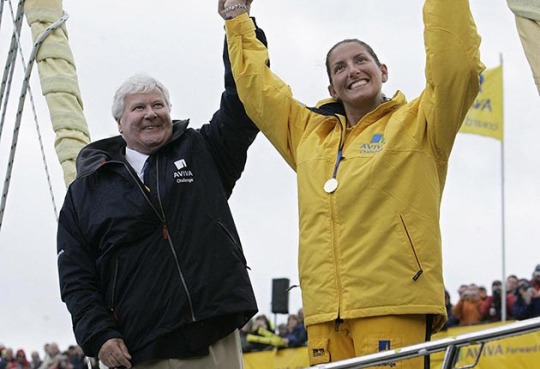
Happy 82nd Birthday Scottish yachtsman, rower and soldier Sir Chay Blyth.
Born Charles Blyth on May 14th, 1940 in Hawick, in the Scottish Borders, the youngest of a family of five girls and two boys. At the age of 15, he left school and went to work for a local knitwear factory as an apprentice frame worker. This career was short-lived as, proudly Scottish, Chay signed at age 18, for the Parachute Regiment where he rose quickly through the ranks, becoming sergeant at the age of 21 – the regiment’s youngest ever Sergeant at that time. In 1966, Blyth teamed up with Captain John Ridgeway to row across the Atlantic from Cape Cod to the Aran Islands in a 20ft dory. They completed this in 92 days.
In 1971, having left the Army three years previously, aboard the 59ft ketch British Steel, he became the first person to sail non-stop westwards around the world against the prevailing winds and currents. Before the attempt, Sir Francis Chichester commented that he thought the voyage was impossible, and on completion it became known as ‘The Impossible Voyage.” The Times newspaper described it as, ‘The most outstanding passage ever made by one man alone’.It is still considered the toughest challenge in sailing; only five people have ever managed it, a number which becomes more significant when compared to the 12 people who have walked on the moon.
The plan began in earnest to sail the ‘wrong way’ round the world in 1969, but it wasn't until 18th October 1970 that Chay Blyth departed from Southampton on board the 59ft ketch, British Steel.
His voyage had never been done before: to sail single-handed, non-stop, westwards around the world. Blyth returned to a hero’s welcome 292 days later.
Since that year, he has accumulated a staggering list of racing successes: 1973/4: skippered Great Britain II in the first Whitbread Round the World Yacht Race with a crew from the Parachute Regiment. They won the elapsed time prize and nine out of the 12 trophies. 1978 he won the Two-handed Round Britain race with Rob James. In 1981 the Two-handed Transatlantic race with Rob James breaking the record
It wasn’t all plain sailing though, pardon the pun, in 1984 Chay capsized in Beefeater II off Cape Horn and spent 19 hours in the water before being rescued; A year later he had to be rescued in the Atlantic from Virgin Atlantic Challenger, which sank. But in 198 Blyth co-skippered ,with Richard Branson, the successful Blue Riband transatlantic attempt on Virgin Atlantic Challenger.
In 1989 Chay founded Challenge Business, a market leader in creating, managing and promoting World Class events, as part of his work with the company he e mentored fDee Caffari on her successful bid to be the first woman to sail around the world against the prevailing winds and currents in 2005–2006.
In 1997, Sir Chay was Knighted for his services to sailing, am not keen on the honours system, but in some cases recognition like this is merited, Chay is a very brave guy who succeeded against all the odds at times in a prusuit of goals that almost cost him his life. The second pic show the pair celebrating her return.
In 2013 aged 73 Chay was still involved in his first love of sailing, in his yacht Wullie Waught he sailed round the world taking part in events worldwide. The yacht’s name was inspired by the great Robert Burns poem.
And there's a hand, my trusty fiere! And gie's a hand o' thine! And we'll tak a right guid willy waught, For auld lang syne.
At the time Chay commented “ My trouble is that I still think I’m a 26 year old Paratrooper instead of a 75 year old with a gammy leg! My mind wanders back now and again”
10 notes
·
View notes
Text
youtube
The Story of Peter Blake
This documentary about the 1989-90 Whitbread Race was offline for a few years due to the original filmmaker, Bryan Bruce, having a dispute with YouTube. Fortunately it’s now back up to watch with Mr. Bruce’s permission!
#whitbread round the world race#Whitbread 1989#steinlager 2#Sir Peter Blake#(not the painter)#tw: smoking#Youtube#tw: swearing
5 notes
·
View notes
Text
A Writer of Two Worlds
Kazuo Ishiguro is one of my MOST favorite all-time authors, I've read most of his works and I'm so excited to share you some of his biography, his books, some trivia, and a personal reflection in this post! Enjoy!

Who is Kazuo Ishiguro?
A British novelist who was born in Japan and moved to London when he was 5
Born November 8, 1954 and is alive presently
He won the Nobel Prize for Literature in 2017
His contemporary fiction novels are themed around preoccupation by memories, their potential to digress and distort, to forget and to silence, and to haunt
His Early Life and Education
At the age of 5, Ishiguro and his family moved from Japan to Britain at Guildford, Surrey until he would leave for university
His family expected to stay temporarily, but they ended staying for a long time as his father’s research continued to be supported by the British government
In the autumn of 1974, he attended the University of Kent at Canturbury to study for a Bachelor of Arts in English literature and Philosophy; he was very influenced by the works of Kafka and Proust; giving him his writing style of unreliable narrators
In 1976, he began to work on his first (unpublished) novel
He graduated in 1976, and by then had been exposed to various authors like Bronte, Austen, Doestoyvesky, Tolstoy, and the Socratic dialogues of Plato
He continued to write his own fiction, starting his second novel in 1977 (unpublished again)
In 1979, he applied for a place in the then small course of Creative Writing at the University of East Anglia, which was run by the renowned professor and novelist Malcom Bradbury
At UEA, he began to publish short stories in small literary magazines which garnered his contract by the London publishing house Faber and Faber who offered him a contract; from here, his writings began attraction immense attention and popularity

Selected Best Works
“I am a writer who wishes to write international novels. What is an 'international' novel? I believe it to be one, quite simply, that contains a vision of life that is of importance to people of varied backgrounds around the world. It may concern characters who jet across continents, but may just as easily be set firmly in one small locality.”
The Remains of the Day (1989)
post-war fiction
Synopsis: Protagonist Stevens is a butler who has a longtime history working at the Darlington Hall located in Oxford, England. In 1956, while taking a trip to see a colleague, he reminiscences about the events that happened at Hall in the 1920s and 1930s
received the Man Book Prize for Fiction in 1989
Aa1993 film adaption was nominated for 8 Academy Awards

An Artist of the Floating World (1986)
historical and global literature
Synopsis: Set in post war WWII Japan, narrator Masuji Ono, an aging painting, looks back at his fallen reputation, how his own attitude and perspective have changed towards the world, the Japanese society, and his art
won the Whitbread Book of the Year Award
explored his reconnection and personal feelings of his Japanese heritage

Never Let me Go (2005)
dystopian science fiction
Synopsis: Takes place in an alternate reality of England in the 1990s where human cloning was authorized. Kathy, a carer, reminisces about her time at the boarding school, Hailsham, where she and her friends had been apart of the boarding school's strict and rather strange lifestyle.
receiving many positive reviews, the novel ranked 4th on The Guardian's list of the 100 best books of the 21st century

Klara and the Sun (2021)
dystopian science fiction story
Synopsis: The story is set in a society in which some children are genetically engineered for enhanced academic ability. Androids can be bought as companions and Klara, an AF (Artificial Friend) learns about the society outside the glass of the display window.
Garnering positive reviews, the novel ranked 6th on the New York Times Bestseller for the week ending March 6th

a
Trivia
His first job was a grouse beater for the Queen Mother at Balmoral Castle (the British royal family’s summer retreat) in 1793
He worked as a social worker for six months in 1976 in a “multiple-deprived” area and he became sensitive to political issues
He wrote two screenplays for TV in 1984 and won the Golden Plague Best Short Film at the Chicago Film Festival
He worked as a lyricist for the jazz singer Stacy Kent, collaborating with the composer and saxophonist Jim Tomlinson
He presently lives in London with his wife and daughter
Reflection
This is a personal opinion but Ishiguro's works reminds me much of Haruki Murakami's writing. Especially when I was reading "An Artist of the Floating World" and "Klara and the Sun". They're both introspective fiction, the kind that talks about the mundanity of life, and bringing it to light, to something complex yet tangible that makes people hang onto every word. Ishiguro's style is by means not straightforward; it's intricate, with thoughtful word choices and phrases, and some of his works aren't exactly engaging right off the bat. But there is something that the two of them--Ishiguro and Murakami-- have in common; a haunting tale. Not in a scary way; in a way that makes you think about the ending, makes you want to go back and re-read some scenes and chapters. However, while Murakami evokes a sense of realism and sad nostalgia with his unique characters, Ishiguro explores reconstruction and interpretation through history through his unreliable characters that tend to deceive than reveal.
Ishiguro's settings are mainly British characters, set in England. However, his works, "An Artist of the Floating World" and another work, "A Pale View of the Hills" (1982) is a self-discovery journey of Ishiguro's Japanese heritage. As said before, he had been born in Nagasaki, Japan, attending kindergarten there and learning the basics of the Japanese alphabet. He moved to London when he was 5 and has stayed there since. The works mentioned above explores the culture and attitudes of the Japanese people; their trait for being introspective as they reflected on their lives. In the making of "An Artist of the Floating World", Ishiguro was praised to be a writer of both worlds. He was influenced by his traditional Japanese mother and he continued to stay connected to his heritage through Japanese literature and novels, noting the differences between Western and Eastern societies, and developing a sense of Japanese ideals. In a way, he was going back to the fading memories he remembered when he was younger, and evoking a sense of nostalgic youth and passing time.
It's one of these backstory context that I learned while I was researching that made me love his works even more. Thank you reading through all the way and I hope you guys give his works a read!
References:
“Kazuo Ishiguro | Biography, Books and Facts.” Famous Authors, FamousAuthors.org, www.famousauthors.org/kazuo-ishiguro.
“Kazuo Ishiguro - Literature.” British Council Literature, British Council, literature.britishcouncil.org/writer/kazuo-ishiguro.
“Kazuo Ishiguro Biographical.” NobelPrize.Org, Nobel Prize Organization, www.nobelprize.org/prizes/literature/2017/ishiguro/biographical.
#kazuo ishiguro#contempt. lit#never let me go#an artist of the floating world#klara and the sun#the remains of the day#world literature#english#literature
47 notes
·
View notes
Photo

Dame Penelope Margaret Lively was born on March 17, 1933. She is a British writer of fiction for both children and adults. Lively has won both the Booker Prize (Moon Tiger, 1987) and the Carnegie Medal for British children's books (The Ghost of Thomas Kempe, 1973).
Lively first achieved success with children's fiction. Her first book, Astercote, was published by Heinemann in 1970. It is a low fantasy novel set in a Cotswolds village and the neighbouring woodland site of a medieval village wiped out by Plague.
Lively published more than twenty books for children, achieving particular recognition with The Ghost of Thomas Kempe and A Stitch in Time. For the former she won the 1973 Carnegie Medal from the Library Association, recognising the year's best children's book by a British subject. For the latter she won the 1976 Whitbread Children's Book Award. The three novels feature local history, roughly 600, 300, and 100 years past, in ways that approach time slip but do not posit travel to the past.
Lively's first novel for adults, The Road to Lichfield, was published in 1977 and made the shortlist for the Booker Prize. She repeated the feat in 1984 with According to Mark, and won the 1987 prize for Moon Tiger, which tells the story of a woman's tempestuous life as she lies dying in a hospital bed. As with all of Lively's fiction, Moon Tiger is marked by a close attention to the power of memory, the impact of the past upon the present, and the tensions between "official" and personal histories. She explored the same themes more explicitly in her nonfiction works, including A House Unlocked (2001) and Oleander, Jacaranda: A Childhood Perceived (1994), a memoir of her Egyptian childhood. Her latest nonfiction work Ammonites & Leaping Fish: A Life in Time, (latterly known as Dancing Fish and Ammonites: A Memoir) was published in 2013.
Beside novels and short stories, Lively has also written radio and television scripts, presented a radio programme, and contributed reviews and articles to various newspapers and journals.
Lively is a Fellow of the Royal Society of Literature. She is also a Vice-President of the Friends of the British Library. She was appointed Officer of the Order of the British Empire (OBE) in 1989, Commander of the Order of the British Empire (CBE) in 2001, and Dame Commander of the Order of the British Empire (DBE) in the 2012 New Year Honours for services to literature.
Lively was shortlisted for the Booker Prize: once in 1977 for her first novel, The Road to Lichfield, and again in 1984 for According to Mark. She won the 1987 Booker Prize for her novel Moon Tiger.
Daily inspiration. Discover more photos at http://justforbooks.tumblr.com
7 notes
·
View notes
Text

noticeably in Poland and Lithuania, predominantly Roman Catholic countries. [5][6]
The Satanic Verses is the fourth novel of British-Indian writer Salman Rushdie. First published in September 1988, the book was inspired by the life of the Islamic prophet Muhammad. As with his previous books,
Rushdie used magical realism and relied on contemporary events and people to create his characters. The title refers to the Satanic Verses, a group of Quranic verses about three pagan Meccan goddesses: Allat, Al-Uzza, and Manat. [1] The part of the story that deals with the "satanic verses" was based on accounts from the historians al-Wagidi and al-Tabari. [1] The book received wide critical acclaim, was a
1988 Booker Prize finalist (losing to Peter Carey's Oscar and Lucinda), and won the 1988 Whitbread Award for novel of the year. [2]
Timothy Brennan called the work "the most ambitious novel vet published to deal with the immigrant experience in Britain".
The book and its perceived blasphemy motivated Islamic extremist bombings, killings, and riots and sparked a debate about censorship and religiously motivated violence.
Fearing unrest, the Rajiv Gandhi government banned the importation of the book into India.
[3](4] In 1989, Supreme Leader of Iran Ruhollah Khomeini declared a fatwa against Rushdie, resulting in several failed assassinations CLONES
1 note
·
View note
Text
1989 год. Кругосветная регата Whitbread. Яхта, команда которой состоит исключительно из женщин… Это уже вызывает желание посмотреть документальную картину «Мэйден», где спустя 30 лет участницы рассказывают обо всём, что было на суше и в море.
О том, что до последнего момента никто не хотел быть инвестором команды. О журналистах, которые в статьях и на телевидении заранее «топили» все надежды на успех и высмеивали желание «девочек участвовать в мужских занятиях». О мечтах, страхах, неожиданных победах, мастерстве, встрече со смертью и уважении к древней стихии. А также о настоящем феминизме без лозунгов на футболках и криков «Girl Power!».

#русский блог#русский tumblr#киноблог#блог о кино#что посмотреть#фильмы#впечатления#по-русски#мэйден#фильмы о женщинах#феминизм#спорт
4 notes
·
View notes